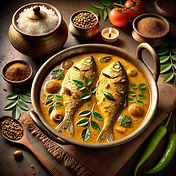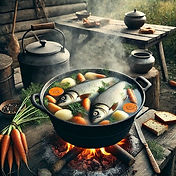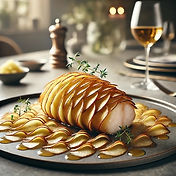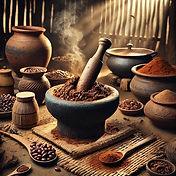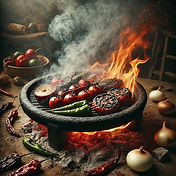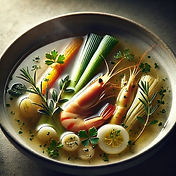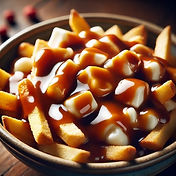Top Chef ™: Wisconsin
Season:
Week:
Elimination Challenge

The chefs were separated into three groups led by host Kristen Kish, head judge Tom Colicchio, and judge Gail Simmons, each of whom assigned their group a unique test.
Gail's group had to create stuffed pasta dishes
Kristen's group had to make soup
Tom's group had to prepare roasted chicken dishes (which were required to include both white meat and dark meat).
The judges selected their favorite and least favorite dish in each group. The overall winner received immunity for the next Elimination Challenge.
The three contestants with the judges' least favorite dishes then cooked against each other in a sudden-death cook-off, creating any dish of their choosing using leftover ingredients from the kitchen. The loser of the cook-off was eliminated.
The guest judges were chefs Paul Bartolotta and Adam Siegel.

Get recipes ...
Subscribe to our weekly recipes and culinary tips from streamed cooking shows.
Dishes prepared in
Top Chef ™: Wisconsin
Chef Valentine: "Today I have roasted harissa chicken with a roasted corn puree and a warm shishito salad with crushed hazelnuts and herbs. There were supposed to be pickled shallots on there, but I forgot them."
Chef Savannah: " I made a roasted chicken avgolemono sauce, chicken skin gremolata, and on the bottom is a potato puree."
Chef Danny: "I did a fennel roasted chicken. Under the breast, the dark meat is tossed in a brown butter espuma. Crispy chicken skin on top of that. On top is the brown butter sherry vinaigrette and a carrot miso puree.
Chef Kaleena: "I made for you, roasted chicken with spiced curry, sweetcorn, lobster mushrooms and grilled shitake mushrooms.
Chef Kenny: " I made a pho-spiced butter with hoisin sriracha and some pho-spices, carrot, coconut, mashed potatoes and scallions."
Gail Simmons: "Kenny, where is the dark meat?"
Chef Kenny: "I ran out of time and missed it."
Chef Amanda: " I made chicken and dumplings. There is a citrus gremolata on the bottom. It has some yuzu kosho and a lot of lemon zest in it.
Chef Laura: " This is yuvalama. It is a mint yogurt soup with bulgur meatballs, morel and maitake mushrooms."
Chef Dan: "I made a tomato and fennel broth. There are some Asian ingredients in there, some lemongrass, ginger, fish sauce and some shira dashi.
Chef Manny: "I made a green pozole with chicken and charred salsa. Then I also charred a tortilla."
Chef Charly: " I grew up in Boston, so I bring you corn and ham soup with pickled shrimp."
Chef Michelle: "I made a ricotta and lobster stuffed pasta. The ricotta has a little bit of lemon in it, and it's sitting in a charred corn sauce. It is garnished with chorizo."
Tom Colicchio, quietly to Kristen Kish: "That's what I call a pasta dish."
Chef Alisha: "I made a ricotta gnocchi, without potato. I stuffed it with roasted mushroom bechamel, whipped truffle, goats cheese, ricotta and a little preserved lemon."
Chef Rasika: "I took inspiration from a dish called kozhukkattai. I made a dough from rice flour and stuffed it with keema, which is spiced ground beef. I paired it with a Kurma, a South Indian vegetable stew."
Chef David: "I made stuffed gnocchi. The farce has mushroom stem. On top of the gnocchi I made a gravy of speck with chicken liver and chicken blood, mascarpone and Calabrian Chili."
Kristen Kish (confirming): " You said this is a gnocchi dough?"
Chef David: "Yes, I'm not keen on pasta."
Chef Kevin: "I made a squid ink raviolo with leek tombée, butter and reduced bisque and cream. Inside you have lobster, shrimp and a fennel purée."
Culinary Challenges inspired by
Top Chef ™: Wisconsin
Meen Moilee is a celebrated Kerala fish curry that exemplifies South Indian coastal cuisine. This luxurious dish features firm white fish gently poached in a velvety coconut milk sauce infused with aromatic spices. The preparation begins by sautéing curry leaves, green chilies, ginger, and onions until fragrant, then adding turmeric, ground spices, and coconut milk to create a golden, creamy base. The fish is carefully added last, allowing it to cook just until tender. The hallmark of Meen Moilee is its balanced flavor profile - mild heat complemented by tanginess from tomatoes or sometimes vinegar, sweetness from coconut milk, and brightness from fresh lime juice. Served with rice, this curry represents the perfect harmony of Kerala's abundant seafood and tropical ingredients.
Ukha is a traditional Russian clear fish broth that dates back centuries, revered for its clean, delicate flavors. This aromatic soup begins by gently simmering whole fish—typically freshwater varieties like pike, perch, or sturgeon—with minimal vegetables and aromatics, allowing the pure essence of the fish to shine through.
The preparation is deliberately simple: fish, onions, carrots, bay leaves, black peppercorns, and occasionally potatoes or leeks. What distinguishes ukha is its clarity—the broth should remain transparent, never cloudy. Often finished with fresh herbs like dill or parsley and a splash of vodka, authentic ukha embodies Russian cuisine's philosophy of highlighting natural flavors rather than masking them with excessive seasonings.
Pommes de terre en écailles, meaning "scaly potatoes" in French, is an elegant potato preparation technique that transforms the humble tuber into a sophisticated side dish. Thin-sliced rounds of peeled potatoes are meticulously arranged in overlapping patterns resembling fish scales or roof tiles in a buttered dish. Each layer is brushed with melted butter and seasoned with salt and pepper before the next is added. The assembled potatoes are then baked until the edges turn wonderfully crisp while the centers remain tender.
The result is a visually striking dish with beautiful textural contrast—crispy, golden exterior scales protecting creamy interiors—that elevates any meal with its refined presentation and rich buttery flavor.
Dawadawa is a traditional West African fermented seasoning made primarily from locust beans (Parkia biglobosa), though occasionally from soybeans or other legumes. The preparation begins by boiling the beans until soft, then pounding them to remove the seed coats. The cleaned seeds are boiled again, spread out, and covered with leaves to ferment naturally for 2-3 days. This fermentation process develops a pungent aroma and complex, umami-rich flavor profile. The resulting black paste is typically shaped into balls or patties for storage. Used as a flavor foundation in soups, stews, and sauces across Ghana, Nigeria, and other West African countries, dawadawa adds remarkable depth and nutritional value to countless dishes.
You can buy dawadawa spice here.
Pipian is a rich, traditional Mexican sauce that exemplifies the complexity of pre-Hispanic cuisine. Made from ground pumpkin or squash seeds (pepitas), this velvety sauce incorporates various chiles, spices, and sometimes nuts or seeds like sesame or peanuts. The ingredients are toasted, ground into a paste, and simmered with broth until thickened to a smooth consistency. Pipian can range from vibrant green (pipian verde) to deep red (pipian rojo), depending on the chiles used. Commonly served over poultry or pork, this sauce offers a nutty, earthy flavor profile with subtle heat that showcases Mexico's remarkable ability to balance complex flavors into harmonious dishes.
Tatemado is a traditional Mexican cooking technique most commonly associated with Jalisco cuisine. This slow-cooking method involves placing ingredients—typically meat such as pork, goat, or beef—into clay pots that are partially buried in hot coals or placed in an underground pit oven. The pots are sealed with masa (corn dough) to trap moisture and smoke, allowing the meat to cook gently for several hours until incredibly tender. This process imparts a distinctive earthy flavor while preserving the meat's natural juices.
Tatemado dishes are often seasoned with regional spices, chiles, and herbs, creating complex flavor profiles that showcase Mexico's rich culinary heritage. The result is meltingly tender meat with unparalleled depth of flavor.
Nage, pronounced "nahj," is a fragrant, aromatic broth used in French cuisine primarily for poaching seafood and vegetables. This delicate liquid is typically created by simmering wine, water, or fish stock with aromatic vegetables (onions, celery, fennel) and herbs. After cooking, the ingredients may be strained out, and the remaining liquid can be reduced and enriched with butter to create a "beurre monté" sauce.
The term 'nage' is also used to describe dishes cooked in this liquid—referred to as "à la nage"—resulting in light, flavorful preparations that highlight the natural taste of the main ingredient while infusing it with subtle complexity.
Poutine: Quebec's Beloved Comfort Food
Poutine is a Canadian culinary treasure originating from Quebec in the late 1950s. This hearty dish consists of three essential components: crispy french fries, cheese curds, and rich brown gravy poured generously over the top, creating a delicious mess of contrasting textures and flavors.
The magic of poutine lies in its seemingly simple yet perfectly balanced combination. When done right, the fries remain crisp on the outside while soaking up savory gravy. The cheese curds, which must be fresh to achieve their signature 'squeak' between your teeth, soften slightly from the heat without fully melting. The gravy ties everything together with its savory depth. It is basically a roux, traditionally thickened with chicken or beef stock but a vegetarian option is just as good, with flavor from umami-rich mushrooms or earthy beets.
To create authentic poutine at home, begin with freshly cut potatoes, twice-fried for optimal crispness - first at a lower temperature to cook through, then at a higher temperature for that golden exterior. The cheese curds should be room temperature and as fresh as possible. Their slightly tangy flavor and distinctive texture cannot be substituted with shredded cheese. For the gravy, create a flavorful stock reduction, thickened to a consistency that coats the back of a spoon without being gloopy.
Assembly requires careful timing. The fries must be piping hot from the fryer, immediately topped with curds and quickly covered with steaming gravy that's hot enough to warm the curds but not so hot it melts them completely.
While traditional poutine remains a beloved classic, modern variations might include toppings like pulled pork, smoked meat, or even lobster. Whether enjoyed from a roadside stand in rural Quebec or prepared in your kitchen, poutine represents comfort food at its finest. it is unpretentious, indulgent, and deeply satisfying.
Soba Cha (also known as Soba-Cha and Sobacha) is Japanese buckwheat tea. It is drunk hot or cold, and is gluten-free and caffeine-free and apparently tastes nutty and slightly sweet.
It appeared three times in Top Chef: Wisconsin ™. The first showing was in Restaurant Wars when Danny's team, under his leadership, served up cold Soba Cha as a welcome drink. It wasn't well received.
In reparation, Danny re-introduced it in week 12 when he infused mushrooms into Soba Cha for his fish dish. This time, the judges regretted that he had buried the flavor of the buckwheat tea in very powerful mushroom flavors and would have preferred the essence of the tea to shine through.
Danny didn't try again, but Dan used Soba Cha in his Smoked Dashi and this time it went down a storm.
Hummingbird cake is a Jamaican banana and pineapple spiced cake which has been eaten in the southern United States since the 1970s. It is a leavened cake with a salty cake and often contains pecans.
Mofongo is a Caribbean dish originating in Puerto Rico and the Dominican Republic. Made by mashing ripe plantains with fat, garlic, spices, and (optionally) pork crackling, it is then shaped into a ball. The dish is famous for its complex and contrasting textures, with fried plantains that are crispy on the outside and soft on the inside. It is often found topped with melted cheese and served with a clear garlic broth.
Danny, in the 'spoiler' for the Top Chef Wisconsin Finale, was heard to say that he wanted to get fresh scallops for his first course and treat them in the style of "Leche de Tigre".
Leche de tigre, (translates to tiger's milk), is the Peruvian term for a citrus marinade that cures fish or seafood. Also known as leche de pantera, this marinade usually contains lime juice, onion, chile, and fish sauce.
















